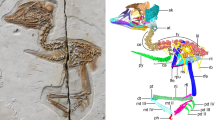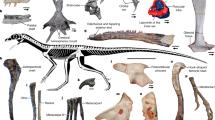Abstract
Features that were once considered exclusive to modern birds, such as feathers and a furcula, are now known to have first appeared in non-avian dinosaurs1. However, relatively little is known of the early evolutionary history of the hyperinflated brain that distinguishes birds from other living reptiles and provides the important neurological capablities required by flight2. Here we use high-resolution computed tomography to estimate and compare cranial volumes of extant birds, the early avialan Archaeopteryx lithographica, and a number of non-avian maniraptoran dinosaurs that are phylogenetically close to the origins of both Avialae and avian flight. Previous work established that avian cerebral expansion began early in theropod history and that the cranial cavity of Archaeopteryx was volumetrically intermediate between these early forms and modern birds3,4. Our new data indicate that the relative size of the cranial cavity of Archaeopteryx is reflective of a more generalized maniraptoran volumetric signature and in several instances is actually smaller than that of other non-avian dinosaurs. Thus, bird-like encephalization indices evolved multiple times, supporting the conclusion that if Archaeopteryx had the neurological capabilities required of flight, so did at least some other non-avian maniraptorans. This is congruent with recent findings that avialans were not unique among maniraptorans in their ability to fly in some form5,6.
This is a preview of subscription content, access via your institution
Access options
Subscribe to this journal
Receive 51 print issues and online access
$199.00 per year
only $3.90 per issue
Buy this article
- Purchase on Springer Link
- Instant access to full article PDF
Prices may be subject to local taxes which are calculated during checkout




Similar content being viewed by others
References
Norell, M. A. & Xu, X. Feathered dinosaurs. Annu. Rev. Earth Planet. Sci. 33, 277–299 (2005)
Northcutt, R. G. Evolving large and complex brains. Science 332, 926–927 (2011)
Dominguez Alonso, P., Milner, A. C., Ketcham, R. A., Cookson, M. J. & Rowe, T. B. The avian nature of the brain and inner ear of Archaeopteryx. Nature 430, 666–669 (2004)
Larsson, H. C. E., Sereno, P. C. & Wilson, J. A. Forebrain enlargement among theropod dinosaurs. J. Vert. Paleont. 20, 615–618 (2000)
Hu, D., Hou, L., Zhang, L. & Xu, X. A pre-Archaeopteryx troodontid theropod from China with long feathers on the metatarsus. Nature 461, 640–643 (2009)
Xu, X. et al. A new feathered maniraptoran dinosaur fossil that fills a morphological gap in avian flight. Chin. Sci. Bull. 54, 430–435 (2009)
Butler, A. B. & Hodos, W. Comparative Vertebrate Neuroanatomy: Evolution and Adaptation (Wiley, 2005)
Gill, F. B. Ornithology (W.H. Freeman, 2006)
Northcutt, R. G. Understanding vertebrate brain evolution. Integr. Comp. Biol. 42, 743–756 (2002)
Jerison, H. J. Evolution of the Brain and Intelligence (Academic Press, 1973)
Northcutt, R. G. & Kaas, J. H. The emergence and evolution of mammalian neocortex. Trends Neurosci. 18, 373–379 (1995)
Nieuwenhuys, R., Ten Donkelaar, J. H. & Nicholson, C. The Central Nervous System of Vertebrates (Springer, 1998)
Gauthier, J., Kluge, A. G. & Rowe, T. Amniote phylogeny and the importance of fossils. Cladistics 4, 105–209 (1988)
Shimizu, T. & Karten, H. J. in Vision, Brain and Behavior in Birds (eds Zeigler, H. P. & Bischor H.-J. ) 103–114 (MIT, 1993)
Rowe, T. B., Eiting, T. P., Macrini, T. E. & Ketcham, R. A. Organization of the olfactory and respiratory skeleton in the nose of the gray short-tailed opossum Monodelphis domestica. J. Mamm. Evol. 12, 303–336 (2005)
Rowe, T. B., Macrini, T. E. & Luo, Z.-X. Fossil evidence on origin of the mammalian brain. Science 332, 955–957 (2011)
Franzosa, J. W. Evolution of the Brain in Theropoda (Dinosauria). PhD thesis, Univ. Texas. (2004)
Witmer, L. M. & Ridgely, R. C. New insights into the brain, braincase, and ear region of tyrannosaurs (Dinosauria, Theropoda), with implications for sensory organization and behavior. Anat. Rec. 292, 1266–1296 (2009)
Bever, G. S., Brusatte, S. L., Balanoff, A. M. & Norell, M. A. Variation, variability, and the origin of the avian endocranium: insights from the anatomy of Alioramus altai (Theropoda: Tyrannosauroidea). PLoS ONE 6, e23393 (2011)
Xu, X. et al. Four-winged dinosaurs from China. Nature 421, 335–340 (2003)
Xu, X., You, H., Du, K. & Han, F. An Archaeopteryx-like theropod from China and the origin of Avialae. Nature 475, 465–470 (2011)
Christiansen, P. & Fariña, R. A. Mass prediction in theropod dinosaurs. Hist. Biol. 16, 85–92 (2004)
Hopson, J. A. in Biology of the Reptilia Vol. 9 (eds Gans, C., Northcutt, R. G. & Ulinski, P. ) 39–146 (Academic Press, 1979)
Rowe, T. B. Coevolution of the mammalian middle ear and neocortex. Science 273, 651–654 (1996)
Bhullar, B.-A. S. et al. Birds have paedomorphic dinosaur skulls. Nature 487, 223–226 (2012)
Smaers, J. B., Dechmann, D. K. N., Goswami, A., Soligo, C. & Safi, K. Comparative analyses of evolutionary rates reveal different pathways to encephalization in bats, carnivorans, and primates. Proc. Natl Acad. Sci. USA 109, 18006–18011 (2012)
Turner, A. H., Pol, D., Clarke, J. A., Erickson, G. M. & Norell, M. A. Basal dromaeosaurid and size evolution preceding avian flight. Science 317, 1378–1381 (2007)
Reiner, A., Yamamoto, K. & Karten, H. J. Organization and evolution of the avian forebrain. Anat. Rec. Pt A 287A, 1080–1102 (2005)
Milner, A. C. & Walsh, S. A. Avian brain evolution: new data from Palaeogene birds (Lower Eocene) from England. Zool. J. Linn. Soc. 155, 198–219 (2009)
Turner, A. H., Makovicky, P. J. & Norell, M. A. A review of dromaeosaurid systematics and paravian phylogeny. Bull. Am. Mus. Nat. Hist. 371, 1–206 (2012)
Acknowledgements
Funding for this project was provided by a NSF DDIG (DEB 0909970) to A.M.B. and M.A.N., NSF IIS-0208675 and EAR-0948842 to T.B.R. and a Columbia University International Travel Fellowship to A.M.B. The University of Texas Computed Tomography Facility and the AMNH MIF helped with computed tomographic scanning and processing imagery. M. Colbert, P. Gignac, D. Ksepka, J. Flynn and J. Meng read and provided useful comments on the text.
Author information
Authors and Affiliations
Contributions
A.M.B., G.S.B. and M.A.N. designed the study. A.M.B. wrote the paper, performed data entry and analytical work, and prepared figures. G.S.B. assisted in data interpretation and helped to write the paper. T.B.R. contributed computed tomography data and assisted in data interpretation. M.A.N. provided computed tomography data and assisted in writing the paper.
Corresponding author
Ethics declarations
Competing interests
The authors declare no competing financial interests.
Supplementary information
Supplementary Information
This file contains Supplementary Figures 1- 3, Supplementary Tables 1 -5 and Supplementary References. (PDF 2659 kb)
Rights and permissions
About this article
Cite this article
Balanoff, A., Bever, G., Rowe, T. et al. Evolutionary origins of the avian brain. Nature 501, 93–96 (2013). https://doi.org/10.1038/nature12424
Received:
Accepted:
Published:
Issue Date:
DOI: https://doi.org/10.1038/nature12424
This article is cited by
-
Origin of the propatagium in non-avian dinosaurs
Zoological Letters (2023)
-
The selfish preen: absence of allopreening in Palaeognathae and its socio-cognitive implications
Animal Cognition (2023)
-
Cranial muscle reconstructions quantify adaptation for high bite forces in Oviraptorosauria
Scientific Reports (2022)
-
‘Dinosaur-bird’ macroevolution, locomotor modules and the origins of flight
Journal of Iberian Geology (2021)
-
Evolutionary and ontogenetic changes of the anatomical organization and modularity in the skull of archosaurs
Scientific Reports (2020)
Comments
By submitting a comment you agree to abide by our Terms and Community Guidelines. If you find something abusive or that does not comply with our terms or guidelines please flag it as inappropriate.



